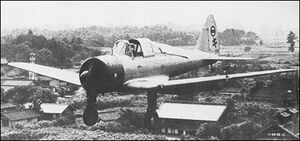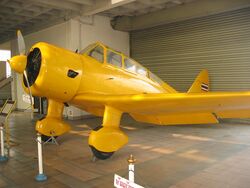Engineering:Tachikawa Ki-55
| Ki-55 | |
|---|---|

| |
| Role | Military advanced training aircraft |
| Manufacturer | Tachikawa Aircraft Company |
| First flight | September 1939 |
| Retired | 1945 (Japan) 1953 (China) |
| Primary users | Imperial Japanese Army Air Force Royal Thai Air Force |
| Produced | 1940 - 1943 |
| Number built | 1,389 |
| Developed from | Tachikawa Ki-36 |
The Tachikawa Ki-55 was a Japanese advanced trainer.
Design and development
The excellent characteristics of the Tachikawa Ki-36 made it potentially ideal as a trainer. This led to the development of the Ki-55 with a single machine gun. After successful testing of a prototype in September 1939, the type was put into production as the Tachikawa Army Type 99 Advanced Trainer.
In all 1,389 Ki-55 were constructed before production ended in December 1943 with Tachikawa having built 1078 and Kawasaki 311.[1]
Both the Ki-55 and the Ki-36 were given the Allied nickname 'Ida.'
Variants
- Ki-36
- Army co-operation aircraft.
- Ki-72
- An evolved version with a 447 kW (599 hp) Hitachi Ha38 engine and retractable undercarriage. Not built.
Operators
 Japan
Japan
- Kumagaya Army Flying School
- Mito Army Flying School
- Tachiarai Army Flying School
- Utsonomiya Army Flying School
 Manchukuo
Manchukuo
 Reorganized National Government of China
Reorganized National Government of China
- National Government of China Air Force received several from the Japanese.
 Republic of China
Republic of China
- Republic of China Air Force operated captured aircraft.
 People's Republic of China
People's Republic of China
- People's Liberation Army Air Force operated more than 30 captured aircraft at the end of 1945. These Ki-55s were used until the last 14 retired in 1953.
 Thailand
Thailand
Francillon also mentions delivery to the Japanese satellite air force of Cochinchina, the southernmost third part of present Vietnam[2]
Specifications (Ki-55)
Data from Japanese Aircraft of the Pacific War[3]
General characteristics
- Crew: 2
- Length: 8 m (26 ft 3 in)
- Wingspan: 11.8 m (38 ft 9 in)
- Height: 3.64 m (11 ft 11 in)
- Wing area: 20 m2 (220 sq ft)
- Airfoil: root: NACA 23014; tip: NACA 23006[4]
- Empty weight: 1,292 kg (2,848 lb)
- Gross weight: 1,721 kg (3,794 lb)
- Powerplant: 1 × Hitachi Ha13a (Army Type 98 450hp Air Cooled Radial) 9-cylinder air-cooled radial piston engine, 380 kW (510 hp) for take-off
- 350 kW (470 hp) at 1,700 m (5,600 ft)
- Propellers: 2-bladed wooden propeller
Performance
- Maximum speed: 349 km/h (217 mph, 188 kn) at 2,200 m (7,200 ft)
- Cruise speed: 235 km/h (146 mph, 127 kn)
- Range: 1,060 km (660 mi, 570 nmi)
- Service ceiling: 8,200 m (26,900 ft)
- Time to altitude: 3,000 m (9,800 ft) in 6 minutes 55 seconds
- Wing loading: 86.1 kg/m2 (17.6 lb/sq ft)
- Power/mass: 0.222 kW/kg (0.135 hp/lb)
Armament
- Guns: one fixed, forward-firing 7.7mm (0.303in) Type 89 machine gun
See also
Related development
Related lists
References
Notes
- ↑ Francillon 1979, p. 254.
- ↑ Francillon 1979, p. 252.
- ↑ Francillon 1979, p. 253.
- ↑ Lednicer, David. "The Incomplete Guide to Airfoil Usage". https://m-selig.ae.illinois.edu/ads/aircraft.html.
Bibliography
- Francillon, René J. (1979). Japanese aircraft of the Pacific War. London: Putnam. ISBN 0-370-30251-6. OCLC 6124909. https://www.worldcat.org/oclc/6124909. (new edition 1987 by Putnam Aeronautical Books, ISBN:0-85177-801-1); 3rd edition 1987, Putnam Aeronautical Books. ISBN:0-85177-801-1.)
- Green, William; Swanborough, Gordon (n.d.). "Pentagon Over the Islands: The Thirty-Year History of Indonesian Military Aviation". Air Enthusiast Quarterly (2): 154–162. ISSN 0143-5450.
 |



